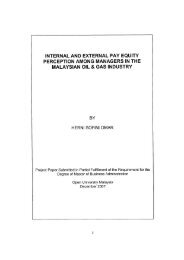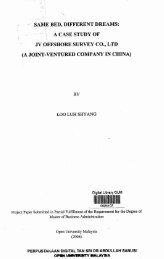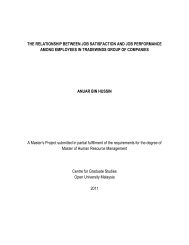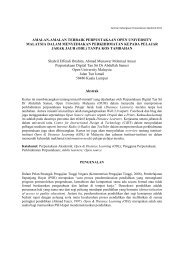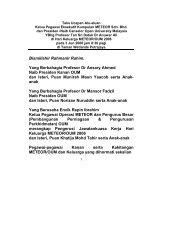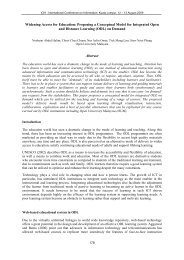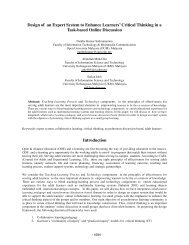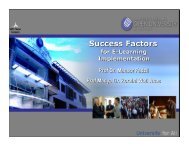Based on Hanley & Spash, (1993); Chan (2009), the CVM is generally divided into six stages. Thesestages are as follows:1. Setting the hypothetical market;2. Obtaining bids;3. Estimating mean willingness-to-pay (WTP) or willingness-to-accept (WTA), or both;4. Estimating bid curves;5. Aggregating the data; and6. Evaluating the CVM exercise5. The Use of CVM To Assess Environmental AmenitiesOne of the earliest practical applications of the contingent valuation method to elicit the market valuationfor nonmarket goods was by Davis (1963) where he estimated the value that hunters and tourists placedon a particular wilderness area. In his study, he found a significant correlation survey result usingestimation on the travel cost method. CVM was even recommended as the assessment when USgovernment agencies were given the power to sue for damage to environmental resources (included nonuse,or existence values) in the 1980s.The importance of valuing nonmarket goods was brought to light with the Exxon Valdez oil spill in PrinceWilliam Sound. Carson et al., (1994) used CVM in a quantitative assessment of damages for the ExxonValdez oil spill in Prince William Sound case. This case used the most carefully developed CVMquestionnaires at that time. Another significant case of CVM application is valuing the preservation ofAustralia’s Kakadu Conservation Zone conducted by Carson et al., (1994). Both of the studies werefunded by their government respectively and both studies also involved a great and in-depth exploring ofthe CVM application on these projects. These studies give a great insight to CVM especially in their stepby-stepapproach and the development of the hypothetical scenarios to represent the assessment ofenvironmental amenities.6. Assumptions Used In CVMThere are several assumptions used in CVM in eliciting the value of non-use goods in the market. It is tobe reminded again that CVM is predicted on a model of an economy comprised of individual decisionmakers who behave rationally in maximizing their own utility taking the considerations of knownconstraints. It is assumed that individuals are the best judges of their own welfare, where each individualcarries equal weight in the aggregation of preferences. CVM works under a well-behaved preferencesystem between goods and the social welfare function contains no arguments other than the welfare ofthe individuals of which society is composed. Generally, CVM accepts that consumers have well-definedpreferences for public goods and that this demand can be measured by the amount of other goods thatthey are prepared to sacrifice to acquire a unit of the good in question.7. Strengths and Limitations of CVMThere are claims that WTP studies can be bias. Biases such as free-riding, the embedding problem,starting-point bias, mixed-good bias etc, can now be effectively controlled for, at least their effects onestimated WTP on the study by Mitchell and Carson (1989). However, the main problem when CVM takeson a specific significance when WTP techniques are applied to cultural goods is the information problem,or in a more precise manner, its converse ignorance. In CVM, it is well-known that the amount ofinformation provided to respondents has a critical effect on their WTP judgments, with well-informedjudgments are better than ill-informed judgments. According to Throsby, (2003) study, in an “ordinary”public good such as national defense or even environmental amenity, it would be able to provide enoughinformation for an informed response to be generated, at least in principle. However, distinguish feature ofcultural goods acquires a taste for them takes time, where they are classed as experiential, their demand
is cumulative, and hence it would be dynamically unstable. Throsby, (2003) stated that individual’s WTPwill not be able to provide a complete view of the nonmarket value of a cultural good. For example, anindividual may acknowledge that a good has a value to him/her but he/she cannot meaningfully representthe benefit he/she gained from this good in monetary terms. Other than that, an individual may enjoy thebenefits of being identified as a human being (sharing a common humanity with his/her fellow citizens),but neither he/she are likely able to express the value of this identity in monetary terms, since it is notexchangeable for other goods. Another issue arise from CVM is on the hypothetical market of anonmarketed good. Hypothetical market for nonmarketed good does not encompass a common groundthat both researchers and subjects anticipate.The CVM should be opted when the WTP for the environmental amenity in total is required, as opposedto the WTP for comparison of different values for individual attributes of the amenity (Bateman et al,2002). Therefore, if the researcher would like to find out the value of conserving the current level of acultural heritage as a whole, the CVM should be chosen. Meanwhile, if the researcher, on the other hand,would like to find the value of observing one level of a cultural heritage versus a different level of thecultural heritage, then the Choice Modeling (CM) 2 method should be opted.8. ConclusionCVM lies under a set of assumptions and based on hypothetical scenarios and questions. Despite itsunderlying weaknesses, quite a number of progresses have been made in refining CVM techniques toovercome the formidable difficulties in its application. There have been vast studies on the estimation ofeconomic values for nonmarket goods throughout the past two decades. Although there is a growingrecognition of the broader economic value of cultural goods by academics, government policy makersand industry, there are not many studies undertaken in Malaysia to estimate their economic value acrossthe whole nation. The future research can be done on valuing the benefits of preserving the cultural livingheritage in Malaysia, a developing nation using various SP approaches in a hypothetical market.2 Choice modelling attempts to model the decision process of an individual or segment in a particular context.Choice modelling may also be used to estimate nonmarket environmental benefits and costs. It is another SP methodavailable for making probabilistic predictions about human decision making behaviour.



